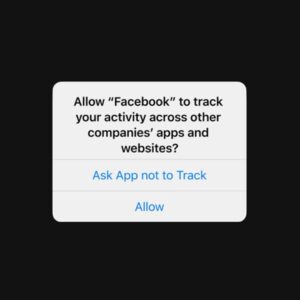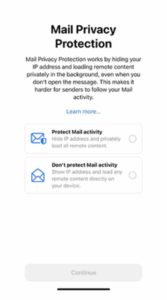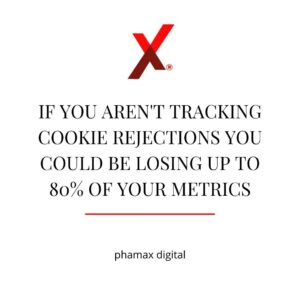Every digital marketer lives for the metrics – who, where, when and what they did when they got there – this is digital marketing gold.
But if 80% of your clicks are disappearing, how do you prove your work is effective?
Recent updates to Apple iOS and Google Chrome combined with local privacy legislation requiring cookie acceptance (e.g. GDPR in EU), plus increasing privacy concerns are going to have an impact on your metrics.
Understand the situation so you can prepare for it.
Apple’s big privacy update
In April 2021 Apple launched its iOS 14.5 update including App Tracking Transparency (ATT) allowing iPhone and iPad users to opt out of tracking in mobile apps that monitor their behaviour and share that data with third parties.
Apple mobile users are now given a notification for permissions for an app to “track your activity across other companies’ apps and websites”.

The option to refuse tracking has always been available but previously consumers had to actively change multiple settings to prevent it. Now Apple offers this in 1 click. And insists on the choice upfront for each mobile app.
As more consumers are concerned about privacy (and the healthcare and life sciences industry more than most!), will people choose to be tracked?
So far statistics are mixed but most reckon only 4-12% of iOS 14.5 users opt into all tracking and 3-5% of users allow some tracking.
That leaves around 80% of iPhone users not providing metrics for in app usage.
What does this mean for my website statistics?
If your marketing strategy is focused on websites rather than mobile apps and app downloads – honestly this particular update will have very little impact on you.
This update is focusing specifically on apps that users download to their mobile. Desktop users, Android users and those who access your marketing through browsers like Chrome and Safari will be relatively unaffected by this update even on their iPhone or iPad.
But there’s also email
With 62% of HCPs placing email in the top 3 ways for discovering scientific content it’s a key pillar in healthcare communication.
And success is often judged on Open Rate (and hopefully a Click Through Rate too!).
But Apple’s update will also affect your Open Rate with the introduction of Mail Privacy Protection. This new, free service from Apple Mail will allow users to opt in to mail privacy features that mask IP addresses and block third parties from tracking email opens or other IP data.

Apple Mail and Apple mobile devices make up over 35% of the email provider market share globally so, while everyone is adjusting, you may need to revise your anticipated open rates or place more emphasis on Click Through Rate or other metrics.
Combined with cookie acceptance – how much data are you losing?
Since the introduction of the EU’s GDPR legislation and California’s CCPA as well as other more localised privacy regulations, cookie permissions are now on every web page!
But what happens to the metrics of the users who “Reject all”?
Are they disappearing into a black hole?

While we all expect a small difference between the numbers of “clicks” the banner vendor reports and those that actually show up in your Google Analytics account, if you aren’t tracking cookie rejections this difference can escalate to nearly 80%! Particularly in a population like HCPs which is very concerned about privacy.
To address this Google has developed Consent Mode. When implemented, this allows Google Tags to determine whether or not permission has been given for your site to use cookies for advertising purposes for that user. If a user consents, conversion measurement reporting continues normally. If a user does not consent, Google tags will continue measuring conversions at a more aggregate level.
So while some of the granularity of data and demographics that we are used to in Google Analytics will be harder to find, you should still get those big, headline metrics.
And what about the other big tech players?
Google’s response
Google said Apple’s app tracking update means that once again, mobile app developers “may see a significant impact” on their ad revenue. But that doesn’t mean those focusing on other forms of digital marketing get to relax completely.
Google also feel that, as consumer behavior and expectations around privacy have shifted, the age of cookies and identifiers as a means of tracking user behavior is coming to an end.
In 2020 Google announced that it would phase out third-party cookies in their browser, Chrome, over the next two years. That means that, if delivered on schedule, at the end of 2022 Chrome users will not be tracked via 3rd party cookies. Currently Chrome represents 66.6% of desktop users and 62.48% of mobile internet users. That’s billions of untracked users.
Third-party cookies are little pieces of code that are from a different domain than the one you are currently visiting. They are mostly used to track users between websites and display more relevant ads between websites.
For instance Google or Facebook Ads will track which websites you visit to show you more relevant advertising using third-party cookies.
And in March 2021 David Temkin (Google’s director of product management for ads privacy and trust) wrote in a blog post that “once third-party cookies are phased out, we will not build alternate identifiers to track individuals as they browse across the web, nor will we use them in our products.”
Instead Google is testing a new approaches. Their first, called Federated Learning of Cohorts (FLoC), was intended to allow ads to be targeted at large groups of users based on common interests. However this has since been updated to Topics, which discloses just 3 broad topics or categories to advertisers on site with full transparency to the user.
These are part of Google’s bigger Privacy Sandbox which encompasses a number of different tools and updates to balance the rising demands of privacy-conscious consumers with the financial needs of developers and advertisers. This will also incorporate machine learning to ready its tools like Google Analytics for this post-cookie future.
Facebook’s response
While Facebook is not often a key tool in communicating with HCPs, it is important for patient education. And this update probably has the biggest effect on Facebook ad tracking. Certainly Facebook is the most upset by the change, even taking Apple to court (on behalf of it’s small business customers!?!).
Facebook ads have offered increasingly targeted marketing but advertisers are reporting that “the accuracy of our ads targeting decreased, which increased the cost of driving outcomes for our advertisers. And the other issue is that measuring those outcomes became more difficult.”
In fact a blog written by Meta’s Graham Mudd (VP of Product Marketing, Facebook) suggests that their “estimate is that, in aggregate, we are underreporting iOS web conversions by approximately 15%”
The FT estimates that Snap, Facebook, Twitter and YouTube lose nearly $10bn after iPhone privacy changes. (Although Google, Twitter and Spotify all posted increased earnings!)
Although there are already work arounds in progress,and unique identifiers are not permitted, it is allowed to put similar users together in a large, anonymous group.
So there will still be metrics, just not as detailed or granular as Facebook advertisers had become accustomed to.
What to do for next year?
Revise your figures – make sure that you (and your line manager!) know that there might be some changes to your metrics. Consent Mode will now use conversion modeling for users who don’t consent to cookies. Google says this can recover about 70% of ad-click-to-conversion journeys that would otherwise be lost to advertisers.
Consider whether your previous marketing actions will still have the same effect and whether it is now time to consider a more diverse marketing plan that incentivizes customers who crave personalized, helpful, intuitive, and seamless experiences delivered in a casual and engaging way.
People want BOTH privacy AND personalization. They still want content that is targeted and messaging that speaks to their interests. But the trust to get personalised data is going to be harder to gain. So, think about putting content on platforms that have already established user trust and have existing profile information. These platforms will be able to provide more nuanced data about the people clicking and consuming your content. They will also be able to show that content to your target demographic in a more focused way.
In a digital landscape without cookies, contextual advertising will outperform behavioral ads. For instance Google (which mainly relies on keyword targeting) is outperforming Facebook and Snap (which mainly rely on behavioral targeting).
So while the more traditional advertising approaches such as banners and driving traffic to proprietary websites might be harder, newer ideas such as hosted content and a variety of formats integrated with other platforms might yield surprising results.
